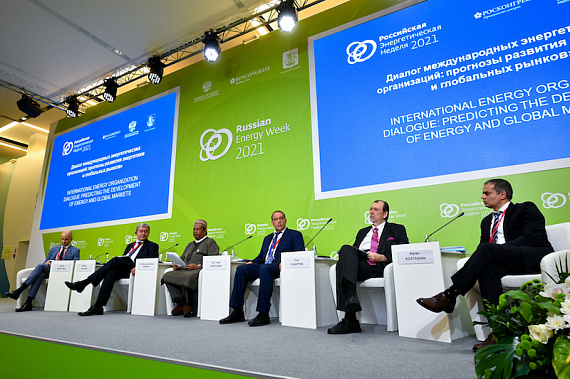Dialogue among International Energy Organizations: Outlook for Energy and Global Markets

KEY CONCLUSIONS
The global energy sector is demonstrating rapid growth and has great potential for further development
“The energy transition is definitely gaining momentum. And this is happening all over the world. We can see that the climate change agenda, the development of new technologies and their accelerated introduction, the more active use of renewable energy sources, and the emergence of new energy carriers are becoming increasingly relevant everywhere. These are all trends that are shaping the current energy agenda. Despite the pandemic, 2020 has set a number of defining trends for the future. On the one hand, we can see that electricity generation from renewable energy sources is being used more actively. It has reached record levels. We can also see that the political agenda is now gaining momentum. To date, some 50 countries, including EU nations, have declared their goal of achieving zero emissions in the foreseeable future,” Association of European Businesses (AEB) CEO Tadzio Schilling said.
“The world is in need of energy and energy resources for the foreseeable future. We are seeing a recovery from coronavirus, which has already begun in 2021. We’ve already reached the bottom and now there’s nowhere to go but up. The trajectory has been set and we are definitely ascending. In our forecast to 2025, we state that the global economy will double. So it’s quite obvious that if we already have such demand for energy, clearly by 2025, if the global economy doubles, it would be logical to assume that demand for energy will continue to grow accordingly since the world needs more energy. Energy is now practically equivalent to development,” Organization of the Petroleum Exporting Countries (OPEC) Secretary General Mohammed Sanusi Barkindo.
Natural gas and renewables can meet energy demand for the foreseeable future
“Absolutely all sources, whether traditional or renewable energy sources, will demonstrate growth. That said, renewables will spearhead this growth for a variety of reasons. First of all, because of the incentives provided by the policies of various governments around the world, [mainly] subsidies [...] We expect oil to continue to lead the way in meeting global demand for the foreseeable future […] Oil and gas together will account for about 53% of the global energy balance by 2045,” Barkindo said.
“Natural gas has very good prospects. Despite what’s going on with prices now, we believe that this resource is accessible both in terms of volumes and price […] We view natural gas as an affordable, flexible fuel that is loyal to the natural environment […] By 2005, natural gas consumption will be about 5.6 trillion cubic metres, a 46% increase compared with today’s consumption volume. So, natural gas consumption will grow, and accordingly, its production will increase [...] We believe renewable energy sources will somewhat outperform natural gas. In the aggregate, though, the synergy of renewable energy sources and natural gas will cover 90% of primary energy consumption and primary energy demand,” Gas Exporting Countries Forum (GECF) Secretary General Yury Sentyurin said.
PROBLEMS
Uneven post-pandemic recovery of global energy markets
“Recovery is proceeding very unevenly following the pandemic. We have encountered unusual weather conditions in Europe. Markets that were previously divided are now converging, and flows are being redistributed. In this complex environment, prices remain a very important indicator. Prices are breaking new records, which is not good for energy of the future. We need stability. And we need predictability,” Schilling said.
“There are encouraging signs that energy is becoming more sustainable. The provision of access to electricity in poorer countries is accelerating. However, greater attention needs to be paid to expanding access to clean and safe fuels […] There is also a huge inequality in the supply of energy between different countries. The gap in per capita consumption of energy resources is as much as 100 times for electricity. For 80% of the world’s population, energy consumption per person is still below the level at which a further increase in energy consumption does not lead to a noticeable increase in the human development index,” said Alexey Kulapin, General Director of the Russian Energy Agency of the Russian Ministry of Energy.
Climate and environmental issues are receiving insufficient attention
“All governments have acknowledged in one way or another that we are in a climate emergency. If we want to move to a cleaner future, we need clean energy,” said Karen Kostanyan, Head of Analytical Research for Russia at Merrill Lynch Securities.
“The world currently needs to pause some processes [...] Zero emissions, carbon neutrality, other issues, the list goes on. There is no final consensus on many of them. A common roadmap is needed on how to achieve these goals,” Barkindo said.
SOLUTIONS
Countries need to cooperate in solving environmental problems
“OPEC and all countries that are members of this organization are involved in the negotiation process on climate change [...] We are now on the right track, and together we can make a great contribution to the organization of this multilateral process. More than 90 countries are involved in these processes. Experts, academics, and scientists from all over the world are now discussing these basic documents related to this concept,” Barkindo said.
“Today, the global fuel and energy industry has a single task – to ensure the world economy develops with both affordable and clean energy sources. And both goals are equally important and must be solved in parallel. Greenhouse gas emissions need to be reduced to prevent climate change, but we also have the goal of eliminating energy poverty,” Kulapin said.
Generate accurate forecasts for the energy industry’s development
“Representatives of countries that are highly dependent on the export of hydrocarbons need to be particularly careful when estimating future demand for oil and gas. Mistakes can be costly and can lead to the death of unnecessary investments or lost revenues for both oil and gas companies as well as national budgets [...] The Russian Energy Agency has started developing its own Russian long-term forecast for the development of global energy for the period until 2050. We want to evaluate the many emerging ramifications in terms of benefits and costs both for our country and for the world as a whole in such areas as the development of renewable energy sources, technologies for capturing and storing CO2, the production of blue and green hydrogen, electric transport, transport based on hydrogen fuel cells, and various types of electricity accumulation,” Kulapin said.
For more, see the Roscongress Foundation’s Information and Analytical System www.roscongress.org





